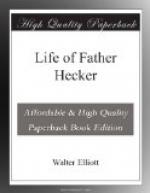His wife, born Ann Elizabeth Schneider, in 1764, was a native of Frankenburg, Hesse Cassel. She became the mother of a son and several daughters, who attained maturity and settled in New York. As his girls grew into womanhood and married, Engel Freund, who was a thrifty and successful tradesman in his prime, dowered each of them with a house in his own neighborhood, seeking thus to perpetuate in the new the kindly patriarchal customs of the old land.
To the New-Yorker of to-day, or, indeed, to any reputable and industrious immigrant, the notion of settling a family in Hester Street could not seem other than grotesque. It is now the filthy and swarming centre of a very low population. The Jewish pedlar par eminence lives there and thereabouts. Signs painted in the characters of his race, not of his accidental nationality, abound on every side. Here a synagogue occupies the story above a shop; there Masonic symbols are exhibited between the windows in a similar location. Jewish faces of the least prepossessing type look askance into eyes which they recognize as both unfamiliar and observant. Women, unkempt and slouchy, or else arrayed in dubious finery, brush against one. At intervals fast growing greater the remains of an extinct domesticity and privacy still show themselves in the shape of old-fashioned brick or wooden houses with Dutch gables or Queen Anne fronts, but for the most part tall tenement-houses, their lower stories uniformly given up to some small traffic, claim exclusive right of possession. The sidewalks are crowded with the stalls of a yet more petty trade; the neighborhood is full of unpleasant sights, unwholesome odors, and revolting sounds.
But the Hester Street of seventy years ago and more was another matter. When a canal flowed through Canal Street, and tall trees growing on either side of it sheltered the solid and roomy houses of retired merchants and professional men, Hester Street was a long way up town. Seven years before the subject of the present biography was born, that elegantly proportioned structure, the City Hall, which had then been nine years a-building, was finished in material much less expensive than had been intended when it was begun. Marble was very dear, reasoned the thrifty and far-sighted City Fathers of the day, and as the population of New York were never likely to settle to any extent above Chambers Street, the rear of the hall would be seen so seldom that this economy would not be noticeable. What is now Fourteenth Street was then a place given over to market-gardens. Rutgers Street, Rutgers Place, Henry Street, were fashionable localities, and the adjacent quarter, now so malodorous and disreputable, was eminently respectable. Freund’s daughters, as they left the parental roof for modest houses of his gift close by, no doubt had reason to consider themselves abundantly fortunate in their surroundings.




